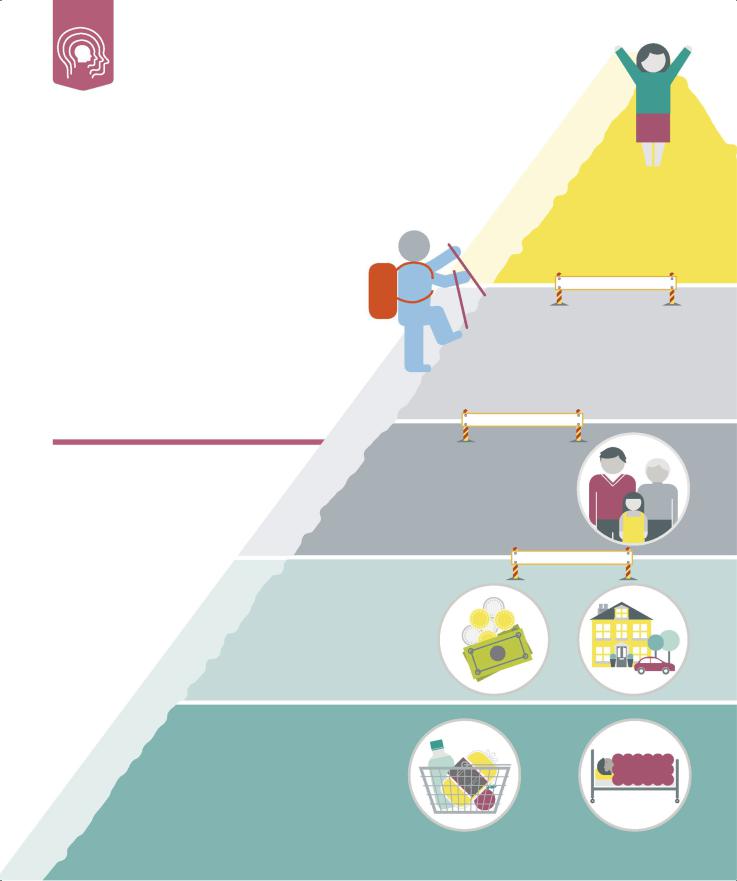Personality
Psychologists have long sought to understand how personality— how someone expresses their identity—develops. Genetics, life experiences, and environment are just some of the factors involved.
What is it?
Personality is the characteristic patterns of thoughts, feelings, motivations, and behaviors that impact how people see themselves, others, and the world around
them. It drives how people feel, how they think, what they want, and how they behave. Personality is what makes each person unique and it influences everything from relationships to careers.
Major approaches to personality
These approaches attempt to understand and explain the complex issues around personality. Some focus on how personality develops, whereas others are concerned with explaining individual differences in personality.
Biological
Psychologists such as Hans Eysenck have emphasized the role of genetic and biological
factors in the formation of personality. This approach suggests that characteristics and traits are determined by brain structure and function, and that they can be inherited—that nature plays more of a role than nurture.
Behaviorist
According to this approach, personality develops through a person’s interaction with
the environment, and continues to evolve throughout their lives. New experiences, meeting new people, and new situations all influence responses and traits.
Psychodynamic
Encompassing the theories of Freud and Erik Erikson, this approach indicates that an
individual’s personality is shaped by unconscious drives and how successfully they resolve a series of psychosocial conflicts that occur at defined stages of life.
Humanistic
Humanists believe that people’s innate desire to realize their potential by exercising free will,
and the personal experiences they accrue as a result of free will, shape personality. Their view suggests that people can take responsibility for who they want to be.
Evolutionary
This approach takes the line that different personality traits evolve at the genetic level
in response to environmental factors. Different traits are therefore evolved adaptations as a result of natural selection or sexual selection. These are traits that in a particular environment increase the chances of reproduction and survival.
Social learning
Related to behaviorist theory, the social learning view is that social interaction
and environment mold personality. Traits develop from observing behavior modeled by others and through conditioning. People internalize actions and responses that feed into their personality. For example, a child who is consistently told that they are naughty internalizes this message and gradually assumes this personality.
Dispositional (trait)
Trait theory proposes that personality is made up of different broad dispositions or traits. How these traits combine and interact is
unique to each person (their “central traits”), although common traits (such as extroversion) may be shared by many people from the same culture. “Cardinal” traits are those that are so dominant that they come to define a person—for example, altruism and Nelson Mandela.
PSYCHOLOGY IN THE REAL WORLD |
150 151 |
Psychology of self-identity |
A number of prevailing theories attempt to understand how people’s individual personalities develop, and to classify personality traits or types. Whereas the biological outlook implies that personality traits are fixed, other approaches, such as the humanistic and behaviorist theories, indicate that environmental factors and experiences modify personality over time. Research using studies of twins suggests that both nature (biological) and nurture
(environmental) play a role in personality. The Big Five personality theory (below) is now widely used to categorize and measure the different characteristics or traits that make up an individual’s personality.
It implies that personality can be malleable—while some traits remain stable and consistent, others may change how they manifest themselves or take greater prominence, depending on the type of situation the individual finds themselves in.
The Big Five personality theory
The most popular and widely accepted model of personality, the Big Five suggests that personality comprises five broad dimensions. Each individual’s personality lies somewhere along the spectrum of these five traits.
LOW SCORE
Practical; inflexible; prefers routine; conventional
Impulsive; disorganized; dislikes structure; careless
Quiet; withdrawn; reserved; prefers solitude
Critical; suspicious; uncooperative; insulting; manipulative
Calm; secure; emotionally stable; relaxed
|
TRAIT |
HIGH SCORE |
O |
Openness |
Curious; creative; |
Includes imagination, insight, |
adventurous; open to |
feelings, and ideas |
abstract concepts |
C |
Conscientiousness |
Dependable; hard- |
Includes thoughtfulness, competence, |
working; organized; |
impulse control, and goal setting |
detail-driven |
E |
Extroversion |
Outgoing; articulate; |
Includes sociability, assertiveness, |
affectionate; friendly; |
and expressiveness |
talkative |
A |
Agreeableness |
Helpful; empathetic; |
Includes cooperativeness, trustworthiness, |
trusting; caring; polite; |
|
altruism, and kindheartedness |
amiable |
N |
Neuroticism |
Anxious; easily upset; |
Includes levels of calmness and |
unhappy; stressed; |
emotional stability |
moody |
CASE STUDY: STANFORD PRISON EXPERIMENT
In 1971 at Stanford University, psychologists set up a simulation of prison life. A group of young men took on the roles of guards; others, those of prisoners. The experiment was terminated after six days because the guards behaved so abusively and
brutally and the prisoners took their extreme suffering so submissively. The study implies not only that all people harbor ugly traits, but also that environment and circumstances can shape behavior and attitudes— effectively altering personality.
“I practically considered the prisoners cattle.”
Stanford University “prison guard”
A person’s need for stability, physical security,
foreseeable employment, resources, health, and property
must be met in order for them to feel safe and free of fear.
Safety
Basic
Maslow thought that people’s behavior is motivated by their desire to fulfill a set of needs. Once lower needs have been met, people are motivated not by deficiencies,
but by a desire for fulfillment and growth. “Peak” experiences are possible when people have
reached the highest state of personal growth.
Self-actualization
This concept attempts to describe what motivates people. It explains the different goals in life that shape behavior, and how individuals can realize their full potential.
|
What is it? |
|
|
Fulfillment |
|
Associated with the theories of humanist psychology |
Self |
-actualization |
|
|
When a person achieves |
|
(pp.18–19), self-actualization means an individual’s |
|
|
|
a self-actualized state, they |
|
desire to realize their full potential. In 1943 |
|
|
|
are doing all that they are |
|
|
|
|
psychologist Abraham Maslow proposed that self- |
|
|
capable of. |
|
actualization formed the pinnacle of a “hierarchy of |
|
|
|
|
needs” that all people strive to fulfill. At the bottom |
|
|
LOSS OF STANDING |
|
of the hierarchy are basic survival needs; once these |
|
|
|
|
are satisfied, individuals aspire to fulfill more abstract |
Esteem |
|
|
concrete goals. These include social needs (for love |
|
|
The individual strives for recognition |
|
and belonging), the need for esteem and respect, and |
|
finally a sense of purpose that is achieved only when |
from others, prestige, and a sense of |
|
achievement, which gives them confidence |
|
people fulfill their true potential—creatively, |
|
in their abilities and boosts self-esteem. |
|
spiritually, professionally—in whatever realm is |
|
|
|
|
|
meaningful to them. |
DIVORCE |
|
|
|
Belonging and love |
F |
|
A |
Hierarchy of needs |
M |
An individual strives to satisfy |
I |
L |
|
their psychological need for love |
Y |
|
|
|
Psychological |
|
|
and belonging through close |
|
|
relationships, family, friends, |
|
|
and within their community. |
|
|
|
JOB LOSS |
Physiological
A person must satisfy their basic needs for air, food, drink, shelter, warmth, and
rest. These needs are usually met in childhood, and must be a given in adulthood
before an individual can start seeking higher needs that make life meaningful.
The psychology of relationships
Psychologists who specialize in relationships are primarily concerned with how relationships work and why they either flourish or break down. The modern approach to relationship psychology is based on the premise that people choose their partners through a combination of biological, social, and environmental factors, and that a key impetus for individuals to build romantic liaisons and families is their genetic drive to form and maintain relationships.
Theories of attachment
Psychologist John Bowlby first developed attachment theory in 1958, backed by research into both human relationships and those of other species. According to Bowlby, a child’s earliest experiences dictate what kind of relationships they form as adults. Multiple studies support this theory, including Harry Harlow’s experiments with rhesus monkeys in the 1950s and 1960s. His findings showed that monkeys who were denied the affection of their own mother grew up to be more timid, less sure of how to behave with other monkeys, and less able to mate. In the 1970s, Mary Ainsworth built on previous experiments, observing interactions between human mothers and infants through a one-way mirror. She concluded that children with mothers who were highly responsive to their needs developed a sense of security in their attachment that children with less sensitive mothers lacked. This security, or lack of it, forms the foundation of adult relationships (pp.156–157).
COUPLES THERAPY
When it emerged as a psychological tool in the 1990s, couples therapy was aimed at getting two individuals to agree to bury their differences. However, based on extensive research by John Gottman at the University of Seattle, therapists now recognize that conflict in a
relationship is inevitable. Couples therefore should try to:Accept conflict and repair rifts.
Improve communication rather than burying their feelings and growing emotionally distant.
Be emotionally open and overcome fears of expressing a need for closeness.
“The quality of your life is … the quality of your relationships.”
Anthony Robbins, American author and life coach
COUPLES THAT PLAY TOGETHER STAY TOGETHER by enjoying small moments of daily life together, which helps to build a strong relationship.
Psychology and attachment
One of the dominant theories in relationship psychology is that a person’s childhood experience of attachment, and in particular, that formed with a caregiver, influences how they behave with a partner as an adult.
Bonding as a baby
The principle that the way in which a person bonds as a baby can dictate how they bond as an adult grew out of the pioneering work of John Bowlby. Like psychoanalyst Sigmund Freud, he was interested
in how early childhood experience affects later life. Bowlby, whose theories were published in the 1950s and 1960s, believed that everyone is born with an
instinctive need to form attachments in order to survive; that everyone needs to have one close, continuous bond for the first two years of their life; and that failure in this process may cause depression, heightened aggression, suppressed intelligence, and difficulty showing affection as a child and later in life.
Over the ensuing decades, psychologists expanded and refined Bowlby’s hypothesis, creating experiments
Childhood attachment
SECURE
When a child feels sure that their needs are met, they develop a secure attachment. The caregiver is sensitive to the child’s needs, responding quickly and regularly. The child is happy enough to explore their environment and feels secure.
AMBIVALENT
The child does not believe the caregiver can be relied on to meet their needs. The caregiver’s behavior is inconsistent—they are sometimes sensitive but other times neglectful. The child becomes anxious, insecure, and angry.
AVOIDANT
If the caregiver is distant and somewhat unresponsive to the child’s needs, that child also becomes emotionally distant, subconsciously detecting that their needs are unlikely to be met. The child does not develop a secure attachment.
DISORGANIZED
The unpredictable caregiver scares the child, either by being abusive or because of their own passive, frightened state. The distressed child grows withdrawn, unresponsive, and confused, with no strategy for having their needs met.
LEADS TO
LEADS TO
LEADS TO
LEADS TO
Adulthood attachment
SECURE
As an adult, they feel confident in relationships and are willing to ask for help from a partner, as well as offer support and comfort to their partner when necessary. They retain independence but are loving toward their partner.
ANXIOUS PREOCCUPIED
Constant fear of rejection drives this adult to be clingy, demanding, and bordering on obsessive, not wanting to be separated from their partner at all. Their relationships are driven by emotional hunger rather than real love and trust.
DISMISSIVE AVOIDANT
Emotionally distant, the adult appears selffocused and independent. The independence is an illusion, a result of denying the importance of loved ones. If their partner is upset and threatens to end the relationship, they appear not to care.
FEARFUL AVOIDANT
The adult swings from one extreme to another, is emotionally unpredictable, and may end up
in an abusive relationship. They are torn between seeking comfort from their partner and being afraid to get too close for fear of being hurt.
The science of love
Psychologists have carried out numerous scientific studies as they attempt to understand the process of falling in love and analyze how a person’s mind works when they are in love.
The rewards of romance
A scientific approach to the reason that people fall in love or commit to a relationship may seem contrary to the idea of romance, but psychologists have proposed some interesting explanations.
In the 1960s Robert Zajonc put forward a theory called the Mere Exposure Effect, which was based on observations of people in the same apartment building.
The theory proposed that one of the main reasons one person becomes attracted to another is due to regular close physical proximity. In another study in the 1980s, Caryl Rusbult observed the relationships of college students and came up with a mathematical explanation as to why people chose to commit or not, and why they may stay in an unhappy relationship. Her Investment Model put forward an equation that
Sternberg’s Triangular
Theory of Love
According to psychologist Robert Sternberg, the ideal form of love combines intimacy, passion, and commitment to create consummate love. Sternberg imagined
the three components as the interactive sides of a triangle. For example, greater commitment may lead to greater intimacy, while greater intimacy
may lead to greater passion. Relationships can have a combination of any of the three components, resulting in one of eight different types of love.
Commitment
A short-term decision to love a particular person and a long-term promise to maintain that love are key to fulfilling a partner, but commitment by itself is an empty form of love.
Companionate
Love
Consummate Love
|
|
|
The ideal love has all |
|
|
|
three components: |
|
|
|
intimacy, commitment, |
|
|
Intimacy |
and passion. |
|
|
|
|
|
Feeling close and |
|
|
|
connected is part of |
|
|
|
a loving relationship, |
Romantic |
|
|
but if this is the only |
|
|
Love |
|
Nonlove |
component it results |
|
|
|
No components |
in liking rather than |
|
|
true intimacy. |
|
|
are present. |
|
|
|
|
Fatuous
Love
Passion
The physical attraction that may have ignited the relationship is a prime component in keeping love alive, but on its own is just infatuation.











